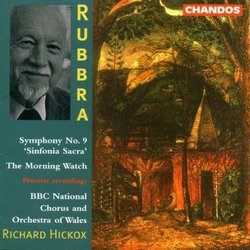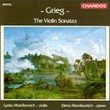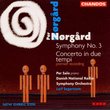| All Artists: Michael George, Stephen Roberts, Edmund Rubbra, Richard Hickox, BBC National Orchestra of Wales, Lynne Dawson, Della Jones Title: Rubbra: Symphony No. 9, 'Sinfonia Sacra'; The Morning Watch Members Wishing: 0 Total Copies: 0 Label: Chandos Release Date: 4/23/1996 Genre: Classical Styles: Opera & Classical Vocal, Historical Periods, Modern, 20th, & 21st Century, Symphonies Number of Discs: 1 SwapaCD Credits: 1 UPC: 095115944127 |
Search - Michael George, Stephen Roberts, Edmund Rubbra :: Rubbra: Symphony No. 9, 'Sinfonia Sacra'; The Morning Watch
 | Michael George, Stephen Roberts, Edmund Rubbra Rubbra: Symphony No. 9, 'Sinfonia Sacra'; The Morning Watch Genre: Classical
|
Larger Image |
CD DetailsSimilar CDs |
CD ReviewsReverent Rubbra Thomas F. Bertonneau | Oswego, NY United States | 12/12/2000 (4 out of 5 stars) "A student of Cyril Scott (1879-1970), who qualified both as a composer of concert-music and an adept of Prisca Theologia (or "the New Age"), symphonist Edmund Rubbra (1901-1986) appears to have inherited a mystical, even a slightly cranky, bent from his teacher. Rubbra found his way back to the semblance of orthodoxy by becoming a Catholic just after World War II. Yet his Catholicism boasted a noticeably offbeat flavor through assimilating not only the teleo-biologism of Teilhard de Chardin but the rather pagan-tinged transcendentalism of the seventeenth century "Cambridge Platonists." When Rubbra decided to cast his Ninth Symphony (1972) in the form of a choral-orchestral Passion, his intellectual penchants all but guaranteed that the result would elude custom in one manner or another. And it did. The full title of the work is Symphony No. 9, "Sinfonia Sacra," Opus 140 ("The Resurrection"). It calls for soprano, contralto, and baritone as well as chorus and orchestra, and it plays for three-quarters of an hour. After a brief orchestral prelude, the baritone sings "Eli, eli, lama sabachthani?" ("My God, hast thou forsaken me?"), followed by Christ's commendation of his own spirit to the Father. The orchestra then develops the melodic material by itself, leading into Rubbra's settings of the Latin hymn "Crux Fidelis" and the Lutheran chorale "Almighty Lord we pray thee" for full forces. These episodes constitute the "First Movement" of this symphony which, however, plays continuously with one exception. The "Second Movement" commences with Gospel narration by the contralto, who sings of the discovery of the empty tomb in recitative, with elaborate orchestral commentary. Rubbra fashions the conclusion of this part of the Ninth on the Latin hymn "Resurrexi," sung as a vigorous fugato with trumpet fanfares to underscore the "Alleluias" and pointilliste contributions from celesta and glockenspiel. The "Third Movement" ends with the "Regina Caeli" and "Abide with Us." At this point, a brief spoken passage presages the "Fourth Movement." A substantial episode for orchestra alone is followed by the appearance of Jesus and his final anastasis. The "Sinfonia Sacra" concludes on "Viri Galilei" and "They Blessing Upon Us." The music remains for the most part in slow tempi - lento seems to have been Rubbra's favorite designation - but this is appropriate to the topic. The Ninth certainly stands apart from Rubbra's eight other purely instrumental symphonies, being perhaps less symphonic than those and more like an oratorio. As a composer for choral voices, Rubbra creates music reminiscent of that of Vaughan Williams or Finzi or Howells. The latter's "Hymnus Paradisi" and "Missa Sabrinesis" often come to mind. The music contains many beauties, but they require time and patience to reveal themselves. Although there's no competition either for the "Sinfonia" or for the accompanying "Morning Watch," the performances under Hickox and his Welsh musicians seem first rate."
|

 Track Listings (11) - Disc #1
Track Listings (11) - Disc #1
